It’s important that you set up your leopard gecko habitat before you bring your new pet home. This way you are assured that the tank/vivarium is designed to your tastes and that everything is working, enabling your new gecko to settle in quickly, feeling right at home.
In this guide, we are going to discuss how to provide your leopard gecko with the perfect habitat to ensure the best health and well-being moving forward.
Table of Contents
Natural Habitat
In order to provide your gecko with the perfect habitat, you need a good understanding of where they come from and their natural habitat in the wild.
Mimicking their natural habitat will help your gecko feel more confident and live a happier life in captivity. These beautiful reptiles can thrive in a naturally designed tank.
The leopard gecko originates from a warm climate. They can be found across Iraq, Pakistan, Afghanistan, and northwest India. Many of the geckos you find in pet shops today have been bred in captivity, yet they still thrive in a natural habitat.
These geckos live in dry and rocky areas which are covered in sand, gravel, hard clay, rocks, bushes, and grass. They tend to live both on and under the ground and are not big climbers.
In fact, if you ever see your leopard gecko trying to climb, they are going to look a little clumsy. The good news is that this means unless there is a piece of wood or high rock, your gecko will not be able to climb out of its tank/vivarium.
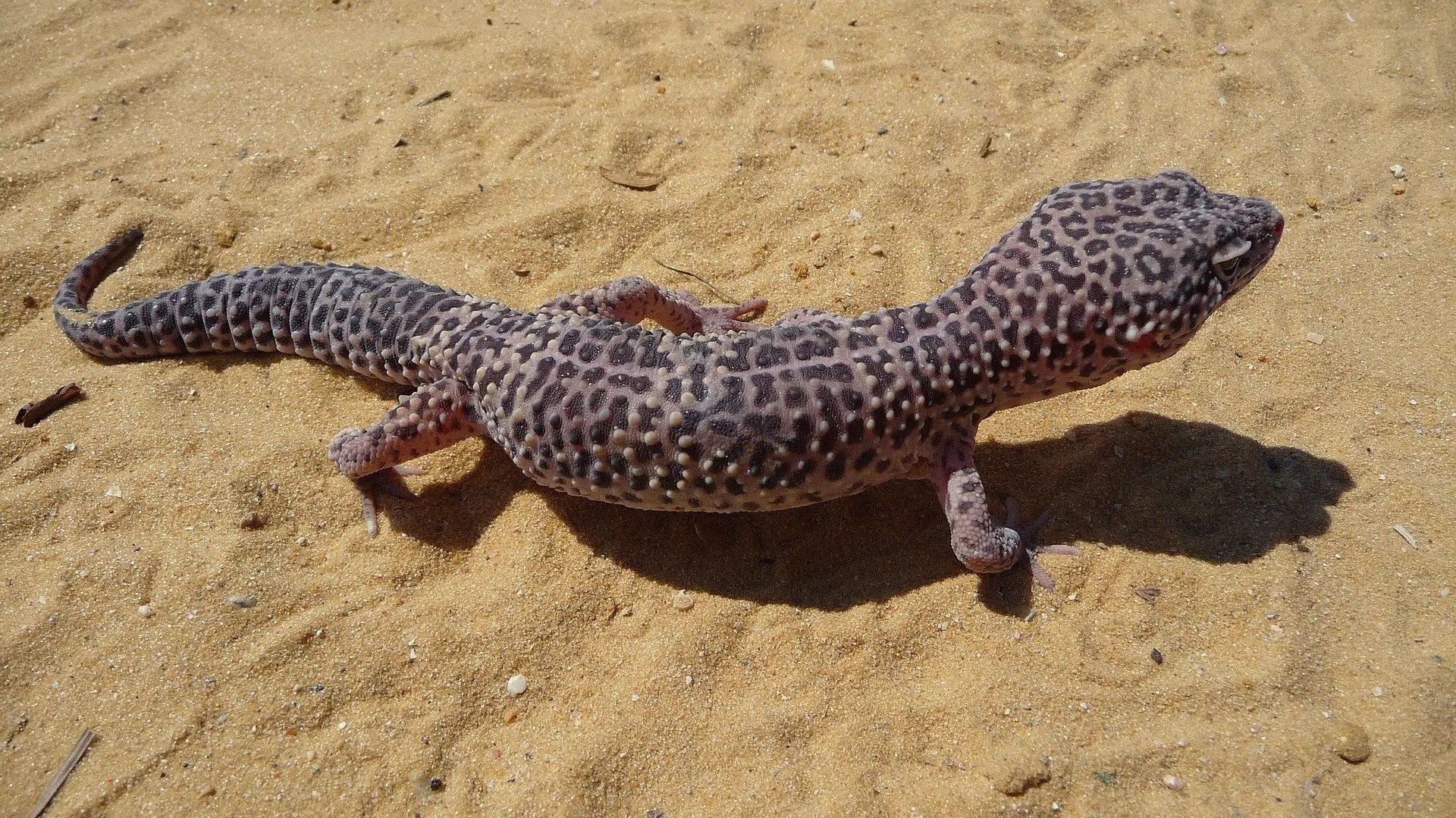
Unlike other lizards such as bearded dragons, leopard geckos are nocturnal. A very important factor to consider when it comes to creating their perfect habitat. Your gecko will hide during the day and become active at dusk.
In their natural habitat, they will hide in holes and under rocks during the day, protecting themselves from predators. Creating the perfect habitat will ensure your gecko is active in the evenings, enabling you to enjoy its unique characters.
Bear in mind that in the wild the leopard gecko can live around fifteen years, this is increased in captivity to up to twenty-five or even thirty years.
What You Need to Create the Perfect Leopard Gecko Habitat
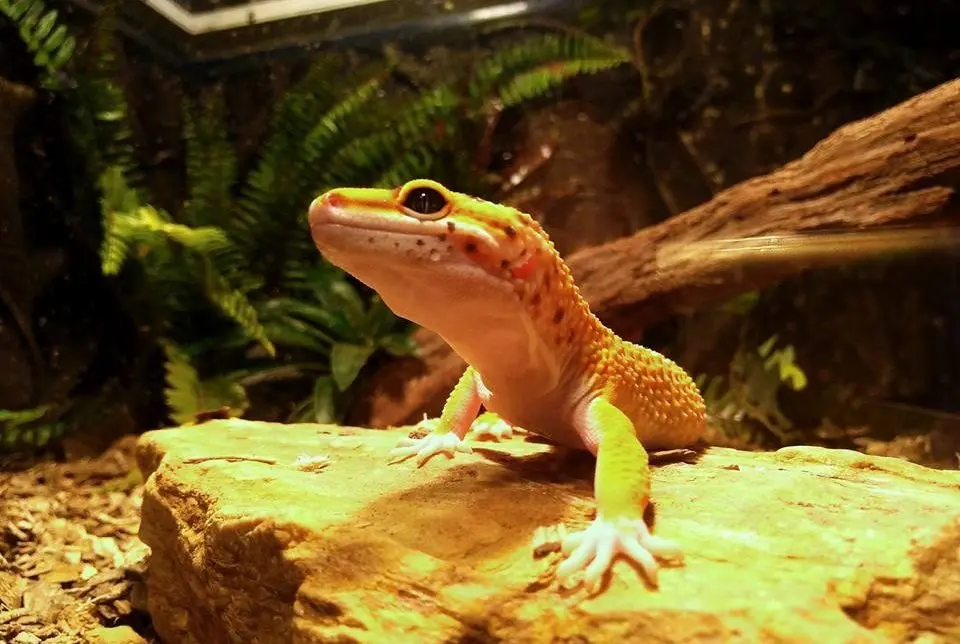
Tank / Vivarium
Your tank selection is a very important decision. The material you choose will determine the viewing of your leopard gecko, while the tank size is imperative to the overall well-being of your gecko.
Never place your tank directly in the sunlight, even though these geckos know a warm climate.
Tank Size
The general rule of thumb is the best size tank for one leopard gecko is a 20 gallon tank. Cohabitation is not recommended for leopard geckos.
Tank Material
There are a number of different materials to choose from to provide your gecko with the best natural habitat within your home, enabling you to watch them entertain you as they run around their tank.
When choosing a tank/vivarium, think of placement, size, and the number of leopard geckos you want to include, along with bearing their natural habitat in mind at all times.
Always ensure the tank you choose offers ample ventilation. This is often achieved by adding a mesh lid to allow for ample airflow. Some of the wooden vivariums come with a mesh front, allowing great viewing with fantastic airflow.
Glass
Class tanks tend to be the most popular choice and also the choice that provides the best visibility.
Glass offers a complete range of benefits including outstanding visibility of your gecko, it’s easy to clean, surprisingly durable and your leopard gecko cannot climb up the side.
In addition to this, glass tanks have proven to be effective in improving humidity, something very important to your leopard gecko and discussed in more detail below in this article.
Plastic
PVC and ABS plastic are the top choices for a plastic vivarium. Plastic is increasing in popularity due to its outstanding durability and being so lightweight.
These tanks are exceptionally easy to clean and provide a clear view of your gecko in the evenings when they become more active.
The downside to plastic is that it does scratch easily, so you want to be mindful of this should you choose this tank material.
Wood
Wood is another of the top choices for a tank/vivarium for your leopard gecko. Wooden vivariums tend to be on the cheaper side, ideal if working to a tighter budget. They have wooden sides with one viewing side, which often is made of glass or mesh.
While wood is affordable and the best choice if you intend to put the tank on a bookshelf, but if you want to be able to view your gecko from all angles, then wood may not be the right choice for you.
Substrate
There is a wide variety of substrates available. You already know your leopard gecko would live with a sandy and rocky habitat in the wild. The choice available should be chosen based on the design of the tank and your personal preference.
Creating a beautiful vivarium can easily be achieved by being selective with your substrate selection while ensuring your gecko has a vivarium as close to their natural habitat as possible.
Sand
Sand is a natural substrate and the ideal choice for your gecko to allow him/her to dig and hide. Sand can provide you with a beautiful base layer to your tank design while offering comfortable footing for your gecko.
Be careful with your selection and choose finer sand to reduce the risk of any sharp pieces. Note that we don’t recommend sand for beginners as it can cause impaction.
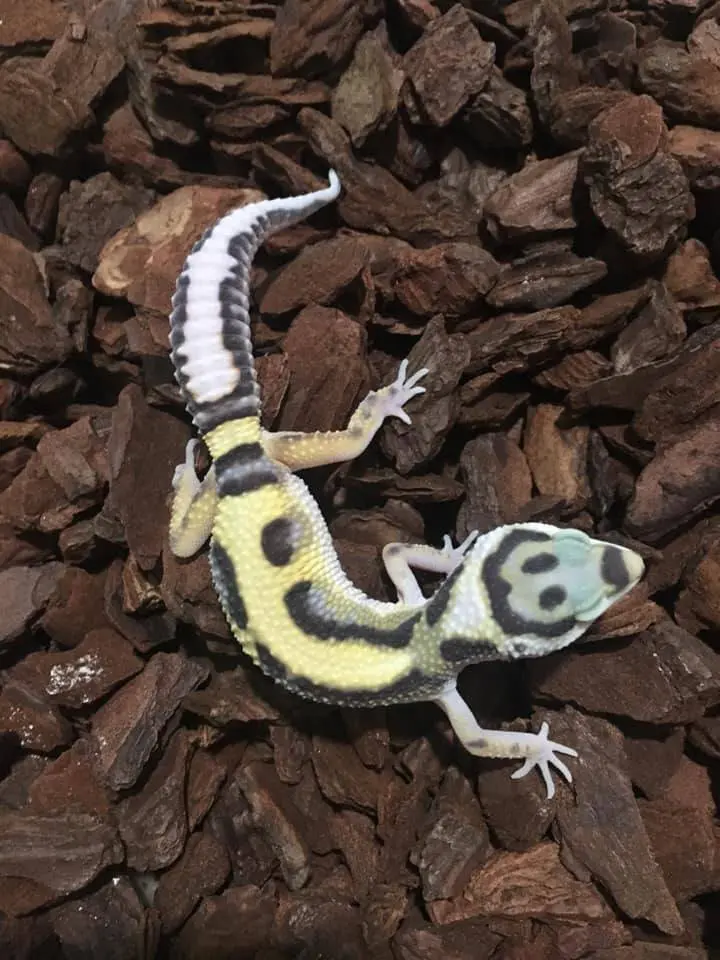
Small pebbles/stones
Small pebbles are another of the top natural choices to line the bottom of your tank to create the perfect habitat. It’s recommended that you mix your pebbles with sand to create a beautiful appearance while ensuring you provide a comfortable and enjoyable place for your gecko.
An important note is never ever used sharp gravel in your leopard gecko habitat, this can result in serious injury for your gecko who tends to dig and clamber over the pebbles and gravel.
Wood Chips
Wood chips and dead grass can provide your gecko with a comfortable habitat, mimicking their natural habitat, while creating a beautiful tank design that is natural and unique. Use a choice of substrates to create an attractive tank for both you and your gecko. If choosing wood chips, ensure you choose a chip that doesn’t have sharp edges that can injure your reptile.
Paper towel
Paper towel has been used by leopard gecko owners for years. It provides your gecko with a firm footing while being super absorbent and quick and easy to clean.
You often see paper towels being used by breeders that keep a large number of geckos at the same time.
You can make use of this beneficial solution to make your tank cleaning quick, easy and hassle free. A dirty towel can simply be removed and replaced within minutes.
A general rule of thumb when it comes to choosing the right substrates
- Natural = sand, stone, river pebbles, clay
- Good = paper towel, reptile carpet, shelf liner, tiles, newspaper, wood chips
- Bad = quartz, walnut shells
Lighting And Heating
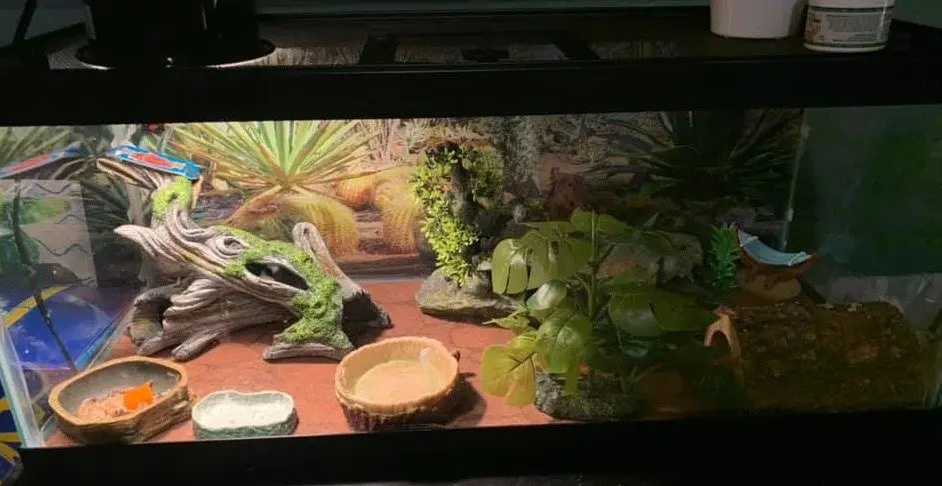
Leopard geckos tend to obtain their vitamin D from their diet, so ultra violet light isn’t really needed.
Even though your gecko doesn’t need UV light, it does need light. Light is important in simulating the day and night cycle while keeping natural plants healthy.
To provide proper heat, under tank heater is the best option for leopard geckos. Please note that you need to connect the under tank heater with a thermostat to ensure the temperature is regulated automatically.
Caution: Don’t forget to turn the light off in the evening—your nocturnal lizard needs time in the dark. This is also the best time to feed your leopard gecko, as they become more active as dusk approaches. It’s recommended that you use a timer to ensure that your light turns on and off at the right times each day.
Decorations
Decorations are for your personal enjoyment and to ensure your leopard gecko feels safe and secure in their new habitat.
Decorations range from hide boxes and rocks to food and water bowls and succulent plants.
Related – Best leopard gecko enrichment.
Hide Boxes
Hide boxes can be purchased at most reptile stores. These are best placed at the bank of the tank. This not only enables you to build up the area easily but if you need to remove the box for cleaning, it is easily accessible.
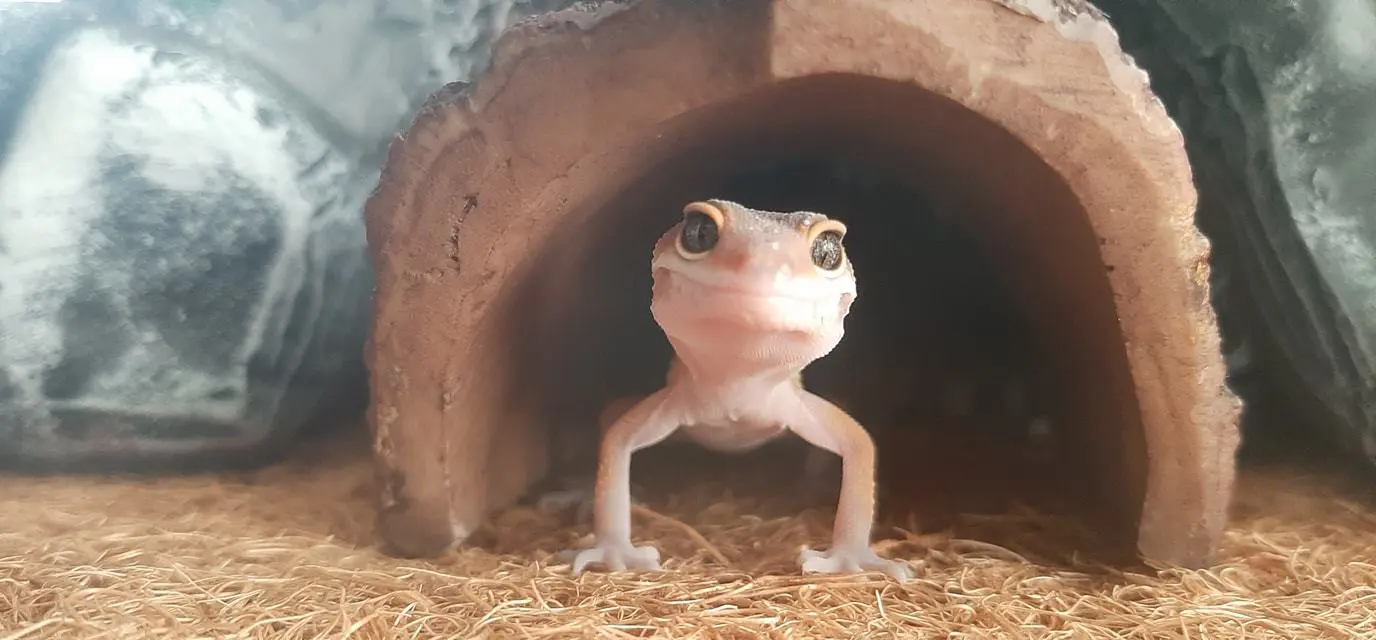
Rocks
Rocks are a fantastic natural addition to your leopard gecko habitat. It provides a natural surrounding for your reptile while creating an attractive tank design.
It’s important to ensure that when you stacking rocks, you secure them to each other. This will help in preventing accidents and injury to your gecko.
Silicone is the perfect choice to secure rocks together. Give it time to set before adding it into the tank.
Be very careful when it comes to placing rocks on a sandy substrate. Remember your leopard gecko is going to want to dig and digging under rocks for shelter is a natural instinct. This can also result in rocks collapsing on your gecko, which could result in serious injury, even death.
Succulent Plants
Succulent plants are a welcome addition to any leopard gecko habitat. These real plants thrive in dry areas, making them the perfect choice to complete your tank design. It’s important that you select the right succulent plant.
Ensure you avoid spiny plants and those with thorns to protect your gecko against injury.
Plants to add to your vivarium includes Aeonium, Schlumbergera, Haworthia, Echeveria, Stapelia, Pachyveria and Lithops.
Food and Water Bowls
You get beautiful and decorative food and water bowls for leopard geckos. Ensure your selection is a shallow bowl which enables your gecko to get to their water and food with ease.
Make sure vivarium cleanup is fast and easy
Make sure all decorations are removeable or set up another way to clear feces and dead food insects from the structures you construct.
Temperature
Your leopard gecko is used to living in a dry climate. Their body temperatures are Dependant on their surroundings, which means it’s important to maintain a constant tank temperature with a warm and cool side.
The ideal temperature for leopard geckos is 75°F to 85°F (24°C to 29°C), with 90°F (32°C) at the basking spot. That’s just the way leopard geckos like during the day. At night it is safe for the temperature in the vivarium to drop to 68°F to 72°F (20°C to 22°C).
|
Area | Temperature |
|---|---|
|
Basking spot | 92 – 94ºF / 32 – 34ºC |
|
General surface | 75 – 85ºF / 23 – 29ºC |
| General air |
77 – 85ºF / 25 – 29ºC |
| Cool side |
above 70ºF / 21ºC |
Use a thermometer to monitor the temperature and ensure your gecko remains healthy and happy.
Humidity
Even though your leopard gecko lives in a dry habitat, they do spend a portion of their day underground. Underground has moisture, which is essential to the well being of your gecko in the long run.
Increased humidity in a leopard gecko habitat is very important. Humidity is essential to the shedding process.
The ideal humidity in a leopard gecko tank / vivarium is 30 to 40%. This can be achieved in a number of ways:
- Choose glass as your tank material. Glass tanks tend to have higher humidity levels.
- Add moss to hide boxes
- Mist regularly
- Use a large water bowl
So i have a leopard gecko and i believe its a black eyed lucy mack super snow. But i cant find any pics to verify it. His eyes are as black as night.
Sand is the worst substrate for Leopard Geckos. This causes them to get impacted.
Yes, I totally agree. Sand is not good for beginners (and also intermediate owners). However, I know some experienced owners using sand for a long time and did not counter any issues. They use a mix of top soil and play sand.